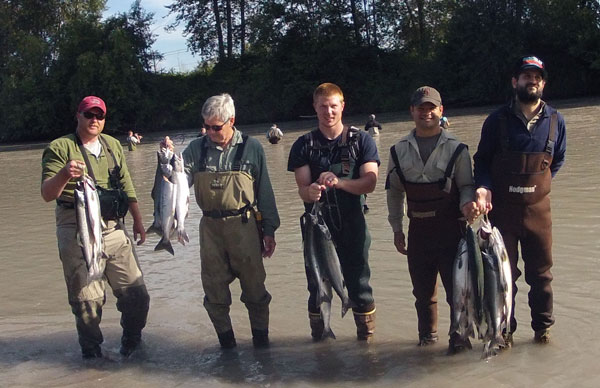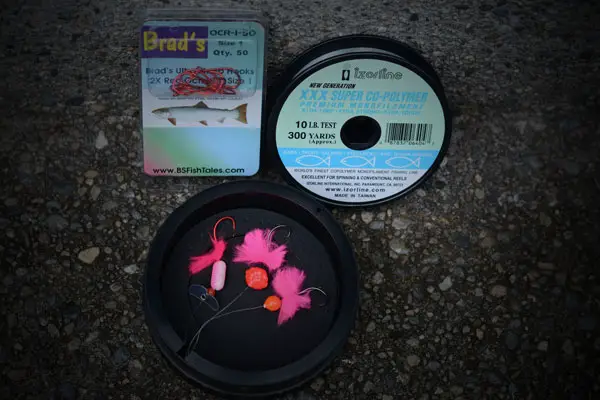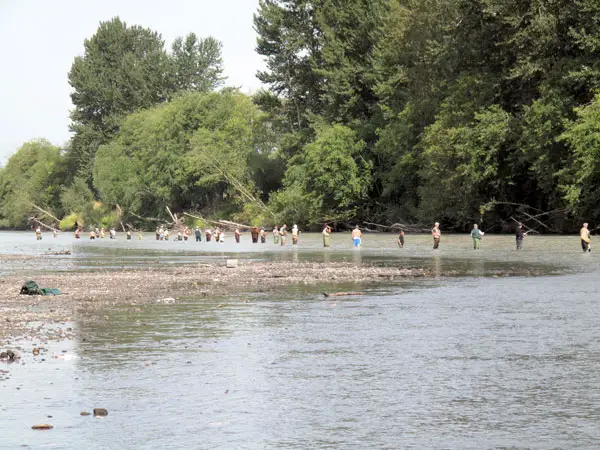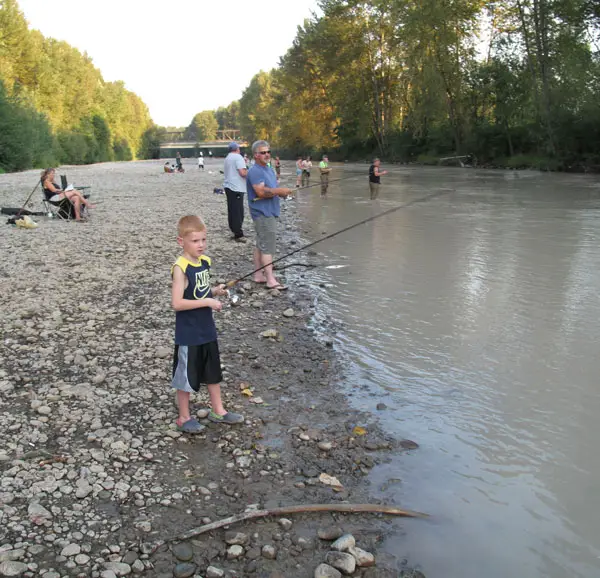Search
Latest Articles
Puyallup River Pinks
by Jason Brooks, July 28, 2015
My father was visiting from out of town for the weekend several years back and I suggested that we go fishing. My oldest son Adam, who was only five back then, was excited at this suggestion as well. So the three of us went down to the Puyallup River which is only a few minutes from my house since the Pinks were running. At the riverbank my father put on his waders and began asking me about Adam who was putting on his size 3 hip boots, the smallest size I could find and were still two sizes too big for the young angler. I reassured my dad that Adam would stand between us and wear his lifejacket, and besides, if Adam fell in he would only be in two feet of water.
While I was explaining this to my father Adam proceeded to wade out with his rod and began fishing. So grandpa waded out just past him as fast as he could. He then overheard a conversation Adam had with a fellow fisherman just upstream. The guy looked over at Adam and asked, “What you fishing for?” Without missing a beat, the 3 ½ foot tall five year old kept his focus on the seam in front of him all the while raising his rod over his shoulder and proceeded to cast his drift fishing gear slightly upstream and in perfect synch with everyone else; then replied back, “Kings, what you fishing for?” Grandpa began laughing out loud and couldn’t believe his grandson’s confident attitude. Adam had one thing wrong, as he had never fished in an odd year before and back then he had only been fishing the rivers for one season, we were actually trying for the pinks.
The forecast for Puyallup River Pinks this year is for over 830,000 to return and the fact that this river has bank access for most of its productive fishing areas it’s no wonder why the gravel bars are popular with the locals. The most prolific fishing spots can turn into the urban combat fisheries that are becoming too common on the Puget Sound river’s but there are spots that are less crowded.
Looking at the entire river you will find most of its banks are controlled with dikes that have a road or a paved bike trail on top. What most people don’t realize is that where the river mixes into the salt of the sound at Tacoma’s tide flats there are great places to fish for the small surface schooling salmon. Pitching buzz bombs by both shore bound anglers and boat anglers along Theas Foss Waterway is a good starting point. Theas Park at the west side of the waterway has public parking and a bulkhead to fish from during high tide. The schools of fish will mill around the mouth of the waterway until they decide to head up into the river. This is also a good place to fish from a float tube or a kayak.
Once entering the river you will find the lower stretch from the 11th street Bridge to the first gravel bar near the “fruit stand hole” on Puyallup’s aptly named River Road about 5 miles upriver is tidal influenced. This part of the river is heavy netted by the Puyallup Tribe and is difficult to navigate by boat. In fact the entire Puyallup River is hard to navigate by jet sled or drift boats mostly due to a lack of launches and the glacial silt chocolate milk waters making boulders or other hazards impossible to see. But there are some that do fish the river in boats, however it is not necessary as the entire river from the first hole until it splits with the Carbon River near the town of Orting, about 15 miles up can be accessed on the bank. If one area isn’t productive, or there are just too many fisherman and you want to get away from the crowds, jump back in the truck and cruise to another access area or walk the river trail system to a quiet spot.
For the bankies: The first hole you come to is the “Fruit Stand Hole” named for the fact that it is across River Road from a fruit stand. To get to this hole take River Road from I-5, which is the Puyallup exit just north of Tacoma. Go about 3 miles towards Puyallup until you will see a fruit stand on the right side of the road (the river will be on your left) and some soccer fields below the stand. Take the next right, onto 44th St East which will lead you back to the soccer fields and a small parking lot. You can’t miss this hole, as once the river opens up (August 10th down this far in the river this year) there will be people out fishing on this gravel bar with cars lined up along river road. Parking here is frowned upon by the Washington State Patrol who will tow your vehicle as this is considered a highway so you’re better off parking near the soccer fields. In the past few years the open field next to the soccer complex charged a nominal fee to park on their lands and it is well worth the few dollars. The soccer complex does not allow for fisherman parking and you will get towed if you try and park in their lot.
Continue upriver to the 66th St Bridge, which is only a mile past the Fruit Stand Hole. Head over the bridge and turn right (upriver) on North Levee Road. About 4 miles up you will see some grass parking areas on your left, and the river will be on your right. Park in the grass areas and cross the road with your rod and gear. Be careful making your way down the levee to the river and you will find several trails through the blackberries to the gravel bars. This is known as the K-Mart Hole because across the river from this gravel bar is the old Puyallup K-Mart. This is a long gravel bar and the fish are channeled to the far side of the river due to a natural funnel. At the top of the run the river widens and deepens a bit and the fish can be anywhere from across the river to swimming between your feet.
Head on up another mile on North Levee Road and you come to another bridge. This one takes you back over the river to Puyallup, and a large Fred Meyers shopping center is just over the bridge. Pull into the Fred Meyers and head towards the river and you will find a parking area. This parking lot is actually for the river trail system, which is a paved trail that runs along the banks of the Puyallup River for several miles. If you walk downriver from the Fred Meyer you will go about a half mile and come to the old K-Mart building and across from the guys on the long gravel bar. There is some bank access here, but you will be on a sandy drop off bank that is difficult to land fish on. Keep walking and you will find some solitude spots that you can step into, but test the murky waters first, as you cannot see bottom and don’t want to step into a deep hole.
If parked behind the Fred Meyer at the trail system parking lot and you decide to walk upriver, you will walk under the bridge that crossed the Puyallup River. You can wade out right under the bridge or anywhere from there upriver for another mile, where you will find Milwaukee Ave. bridge. All along here there is great public access, with either a gravel bar or shallow waters to wade into and fish in solitude. It is possible to get 50 to 100 yards away from other fisherman here. This stretch is known as “Tiffany’s” and named after the roller skate rink next to the bridge, “Tiffany’s Skating”.
Further upriver you can find the “Blue Building Hole” which of course is named for the big blue glass building it sits behind. To get here you need to drive into Puyallup on Meridian, and turn east onto East Main St. Keep on East Main until you cross under highway 512 and you see a large, well, blue glass building. The paved river trail system runs along here as well, and there is another gravel bar to fish on. If you keep driving up East Main towards the town of Sumner, you will once again cross over the Puyallup River. At this bridge you will see the paved trail system once more. The trail will take you to several fishing spots along the bank. Across the river from the trail, or before crossing the river coming from the town of Puyallup on East Main is Mama Storntini’s Restaurant. You can access the river behind the restaurant and an old dirt road will take you to several more bank spots and eventually will lead you to a large sandy bank across from where the White (also called the Stuck) River dumps into the Puyallup River near the wastewater treatment plant. From here upriver to the split with the Carbon the Puyallup gets a bit smaller and in late summer it can be fished like a stream.
Keeping with heading upriver, the next area to fish is near McMillan. New this year, above the Main Avenue Bridge that leads to Sumner from Puyallup is a lower retention limit. The entire lower river is two adult salmon, release wild Chinook, plus two additional Pinks. Upriver from the Main Avenue Bridge it does not have the extra “additional two Pink salmon” rule, make sure you check the regulations before you go for any changes or closures. This is the one area of the river that has limited public access since the banks have turned from dikes and parking lots to flower fields and Christmas tree farms. If you head up the Orting Highway, you start to stray away from the river, but soon find yourself crossing over a much smaller Puyallup just before getting to Orting. There is another public parking lot for yet that same paved trail system at this bridge. If you walk down to the river you will notice that the confluence of the Puyallup and Carbon is about 100 yards downstream. This is the fishing boundary, as the upper Puyallup is usually closed, or has restricted fishing. The pinks are all native, but the system has kings and Coho heading for the hatchery at Voight’s Creek, a tributary to the Carbon River in Orting. The Carbon River is also closed until September 1st, so if you go in August make sure you stay below the confluence.
So, you are probably asking, “great, a river with a ton of bank access, lots of fish, and a liberal season, but what the heck do I use to catch the fish?” Simply put, with its off colored waters and near zero visibility, especially during hot weather when the glacier is melting on Mt. Rainier (the headwaters of the river), the main technique to use is drift fishing. It is also important to use a sensitive rod with enough power or strength to fight the fish. My favorite rod is a North Fork Custom’s Series One 900 which is a 9 foot rod that is medium heavy and has a fast action, rated for 8 to 17 pound test line.
For the terminal end of things there three set up I prefer to use: A Yakima Bait size 12 Red Rocket Lil’ Corky, a pink scale Mack’s Lure Cha Cha Pill Float behind a small bead and a Mack’s Lure Smile Blade, or a Brad’s Orkie Drifter in Glitter Red Rocket. All three set up’s are trailed with cerise yarn on a Brad’s size 1hook (barbed pinched down). These set up’s seem to get the fish’s attention in this murky water and accounts for more legal (in the mouth) hookups and reduced the amount of flossed or foul hooked fish. I have these tied on 30 inches of 10 pound Izorline XXX leaders with 15 pound Izorline Platinum for my mainline.
The reason for the heavier main line is because the Puyallup still gets a run of Kings and some early Coho, but also you can expect to fish with lots of friends and light gear here will either get you yelled at or broke off. It seems if you take more than a few minutes to get the fish in the fellow bankies patients runs out and they start casting. Hey, that’s fishing in an urban area and it is well worth it when you’re talking about landing up to 35 fish day as an everyday day event from its opener in August until mid-September.
In 2015 you will find Adam out with his younger brother, Ryan, fishing with me and their grandpa. So, if you are on the Puyallup and see two fishermen in oversized waders, staring at the runs in front of them and casting drift gear, just politely nod and assume they are fishing for kings…even if their stringers are full of pinks.



